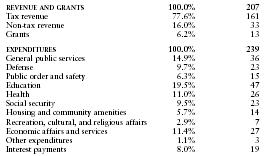Kyrgyzstan - Public finance
During the early 1990s, economic output declined, while inflation escalated. As a result, the proportion of public revenues in GDP plummeted. Transfers from the former Soviet Union amounting to over 11% of GDP largely created an overall budget surplus equivalent to 4.1% of GDP in 1991. In 1992, parliament agreed to a further tightening of fiscal policy (including decreased expenditures and the elimination of transfers to inefficient state enterprises) due to the virtual termination of in-flowing subsidies caused by the demise of the Soviet Union. The som, currency introduced by the government in May 1993, has proven fairly stable, and monthly inflation has slowed from 40% to about 10%.
The US Central Intelligence Agency (CIA) estimates that in 1999 Kyrgyzstan's central government took in revenues of approximately $207.4 million and had expenditures of $238.7 million. Overall, the government registered a deficit of approximately $31.3 million. External debt totaled $1.6 billion.
The following table shows an itemized breakdown of government revenues and expenditures. The percentages were calculated from data reported by the International Monetary Fund. The dollar amounts (millions) are based on the CIA estimates provided above.

| REVENUE AND GRANTS | 100.0% | 207 |
| Tax revenue | 77.6% | 161 |
| Non-tax revenue | 16.0% | 33 |
| Grants | 6.2% | 13 |
| EXPENDITURES | 100.0% | 239 |
| General public services | 14.9% | 36 |
| Defense | 9.7% | 23 |
| Public order and safety | 6.3% | 15 |
| Education | 19.5% | 47 |
| Health | 11.0% | 26 |
| Social security | 9.5% | 23 |
| Housing and community amenities | 5.7% | 14 |
| Recreation, cultural, and religious affairs | 2.9% | 7 |
| Economic affairs and services | 11.4% | 27 |
| Other expenditures | 1.1% | 3 |
| Interest payments | 8.0% | 19 |
Comment about this article, ask questions, or add new information about this topic: